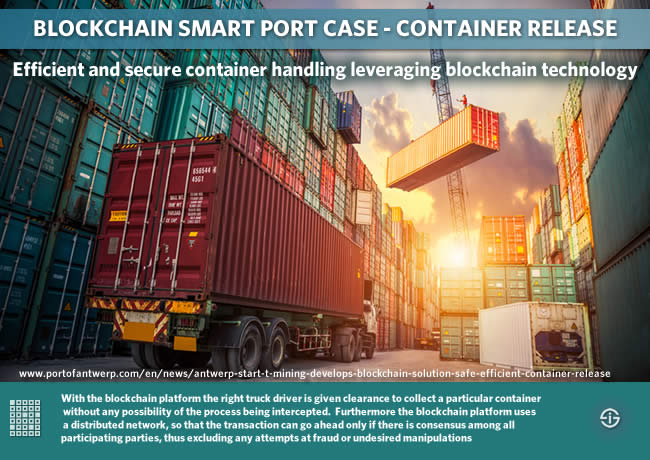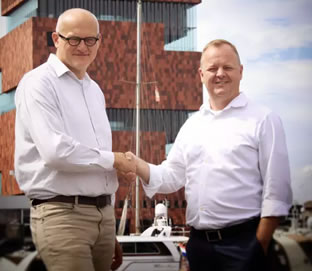The number of smart port projects with a blockchain technology component keeps increasing. In several ports and port cities, such as Hamburg to name just one, blockchain has become part of the broader smart port approach.
Different smart port projects across the globe can have different goals or priorities but IoT, advanced big data (collection, exchange and analytics) platforms and, increasingly, blockchain always are present one way or the other.
Just getting a container from point A to point B frequently involves more than 30 different parties, with an average of 200 interactions between them
As an example of a blockchain smart port project that solves a clear challenge and aims to move beyond its first scope of secure container release towards other smart port applications, is this case whereby in the seaport of Antwerp a blockchain initiative is part of a broader smart port project in an even broader smart city initiative that consists of five pillars aiming to make the Belgian city of Antwerp a European IoT leader.
The port of Antwerp, key in the city’s economy has seen its freight volume grow for several years and is Europe’s second-largest seaport, after Rotterdam (The Netherlands) which has been a pioneer with its own smart port project, carrying the straight-forward name SmartPort.

A blockchain smart port collaboration between a city, its port, a blockchain start-up and the NxtPort data utility platform
In the Summer of 2017 the port of Antwerp announced a pilot project for a more efficient and secure container handling leveraging blockchain technology. End 2017 an update on the project was released, putting it more in perspective.
We take a look and add some additional context in the larger picture of blockchain and maritime logistics.
The blockchain smart port pilot project in Antwerp is realized by a local start-up, T-Mining. It thereby collaborates with NxtPort, one of many other digitalization and smart port projects at the port of Antwerp. NxtPort describes itself as a “data utility platform that will collect and pool data from various stages in the supply chain of the Port of Antwerp”.

NxtPort is a pretty ambitious project which essentially is a big data platform – or Data Utility platform (see our interview with Nxt Port President and Digital Flanders Administrator Barbara Van Den Haute) containing all data from containers across the end-to-end logistics chain, launched early 2017.
The NxtPort project needs to be seen in the scope of efficiency and the same issues, among others regarding paper and data silos, typical challenges in supply chains, the realization of the digital supply chain, maritime logistics and smart logistics and supply chain management overall. Similar projects exist in other ‘smart ports’ such as Hamburg, Singapore and Rotterdam, albeit with a top-down approach whereas NxtPort has a bottom-up approach.
Blockchain and the universal challenges of ports, maritime logistics and supply chain management
Ports, just like all other players in the supply chain ecosystem of cross-border trade often indeed still work in a paper-intensive environment with several stakeholders, traditional communication methods and a high number of transactions and interactions, slowing down operations and efficiency.
Those are all reasons why there are ample blockchain initiatives and collaborations in supply chain management, logistics, transportation, smart port projects and so forth.
So, it’s no wonder that in recent years there has been an increase of blockchain initiatives, partnerships and consortiums in the scope of the usage of blockchain in maritime logistics.
Paperwork accounts for up to half of the cost of container transport
One of the leading players in this regard is Maersk. in 2017 the company struck a partnership with IBM to look at ways to integrate blockchain into its processes. IBM, among others, has been exploring and testing ways to apply blockchain to customs declarations and previously demoed its cross-border supply chain solution on blockchain as a result of the collaboration with Maersk (earlier IBM also launched a cross-border payment blockchain solution).
While the ambitions of Maersk and IBM are of course broader than those of start-up T-Mining and its partners, the Antwerp initiative in the scope of blockchain technology in container logistics will attract the attention of companies like Maersk who are more than serious about blockchain in their entire ecosystem where ports obviously play an essential role. Maersk by the way also is in another blockchain project and collaboration, specifically in the scope of marine insurance.
From container release blockchain application to more smart port blockchain and data initiatives
The blockchain pilot of T-Mining revolves around a particular use case: secure container release. It’s part about efficiency but most of all tackling a challenge that is real: security and certainty, along with efficiency, in picking up containers.
As is the case in all ports, truck drivers picking up containers need to identify themselves. In the port of Antwerp a so-called Alfapass is used for identification. Next a PIN code is generated for the particular container by the port terminal operator who passes it along to the forwarder who arranges the transport and passes the code to the carrier. Those are already quite some involved parties who know that code. Add to that the fact that carriers can subcontract the transport to another haulage company and you start seeing the problem.
Moreover, the PIN is sent in several ways and can be intercepted or passed along to others who you don’t want to pick up your container.
The blockchain solution essentially aims to fully remove the need for a PIN code. In a first stage the PIN code is generated using an app that also adds an additional level of security in the form of geofencing (it doesn’t work unless the driver is on the right premises, namely in the right port terminal where the container is waiting to be released).
In a second stage the goal is to remover the PIN code system entirely and make the whole processes not just more secure but also more efficient trough further automation with a further use of smart contracts in their typical usage context.
We have gathered all the information necessary to release a container in a database. Only the parties involved have access to this information. In addition, digital rights have been created in the blockchain. Only the owner of the corresponding right is allowed to collect the container on the terminal. Thanks to blockchain this right can be transferred between parties. In this way the recipient of the right can be sure that the sender no longer owns it. And so they can also be sure that nobody else can turn up on the terminal, lay claim to the container and make off with it. Everything is recorded in the blockchain (T-Mining’s Nico Wauters replying to a question on a test of the blockchain application)
It’s a specific example of solving a real challenge using blockchain technology in a context of smart ports and maritime shipping – and solving real challenges is what we do want to solve with technologies such as blockchain, certainly in a market where margins are tight, competition is intensive and there is little room for mistakes, to begin with.
While it might be hard to compare with what companies such as Maersk are doing, the ambitions of the port of Antwerp, the city and the various involved stakeholders stretch further and they are looking at more blockchain smart port applications such as entirely mapping the full end-to-end physical flow of a container and document-related applications, to name a few.
Moreover, let’s not forget that it still is relatively early days in blockchain. The folks at start-up T-Mining also did end second in Singapore’s Smart Port Challenge 2017 with the maritime-related “proof-of-concept to increase visibility of the maritime logistic supply chain data from ships, cargo and containers to improve efficiency of global operations”.
Why blockchain smart port and cross-border shipping projects matter
At this stage the goal is to have as many stakeholders such as terminal operators, forwarders, carriers and so on join the blockchain network, now that initial tests have been done.
Yet, this blockchain smart port project shows how even in the relatively limited scope of container release there are ample intermediaries, interactions, risks and opportunities to improve lots of typical logistic challenges and makes clear why blockchain is not just a solution for smart port projects but for maritime logistics as well as supply chain management overall whereby blockchain and IoT become a natural fit.
As the first press release from the port of Antwerp reminded just getting a container from point A to point B frequently involves more than 30 different parties, with an average of 200 interactions between them.
With the majority still happening on traditional channels and using lots of traditional carriers, paperwork accounts for up to half of the cost of container transport.
All the ingredients that make an industry and/or series of activities fit for blockchain are present, whether it’s on this local blockchain smart project level or on a global cross-border shipping and logistics level: a lot of paper, a lot of transactions and interactions, a need for speed, a need for transparency, a need for enhanced security, protection and tracking of valuable assets in trade, enhanced efficiency and so forth.
No wonder that logistics, transportation, shipping, distribution and supply chain management rank high on the list of blockchain spending and blockchain initiatives, right after the financial industry.
More resources on this blockchain smart port initiative
Top image: Shutterstock – Copyright: Travel mania – All other images are the property of their respective mentioned owners.

